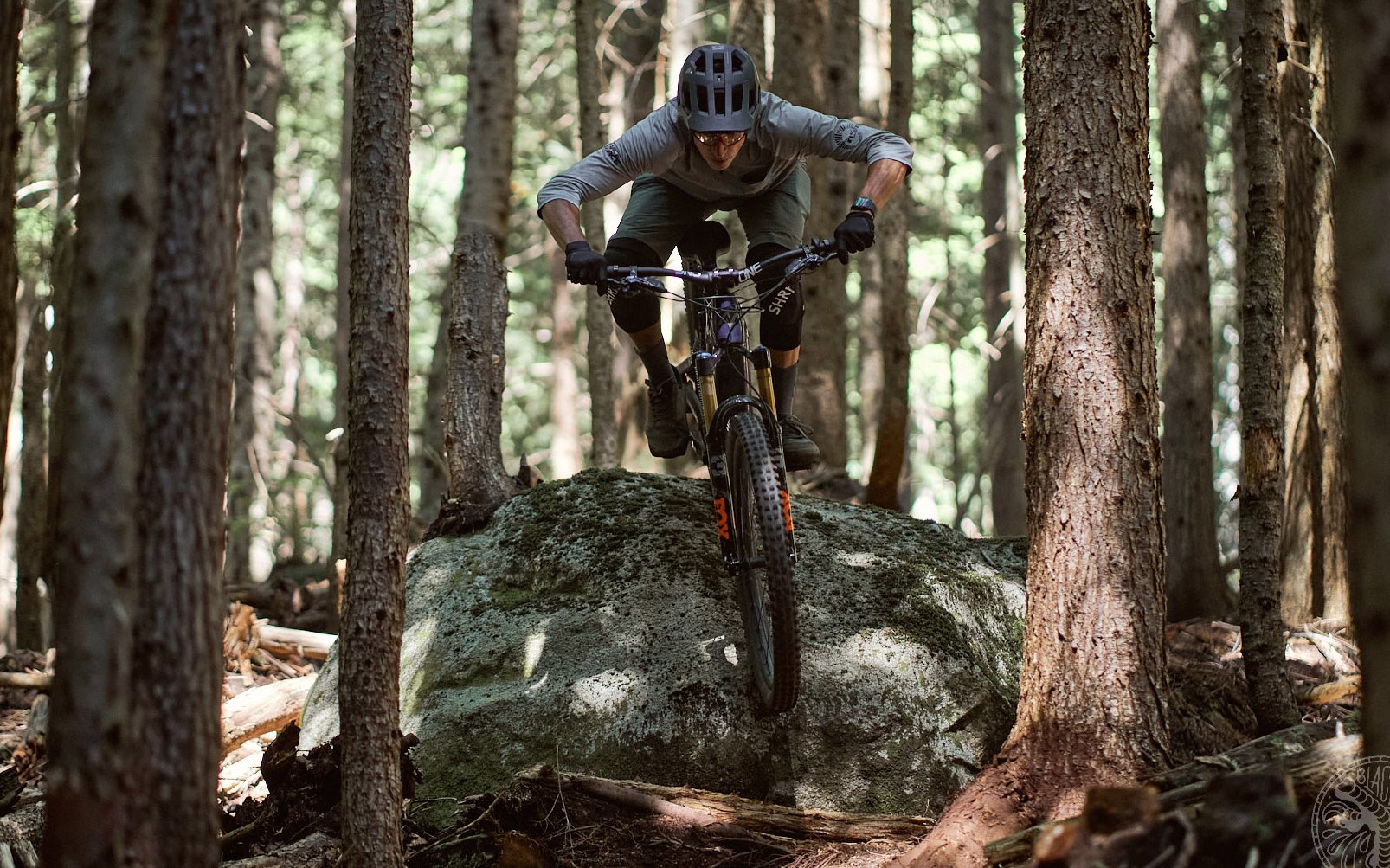
REVIEW
OneUp Carbon E-Bar
Only For E
E-bike-specific parts and accessories are becoming all the rage. You can get obvious eMTB products like cranks, wheels, and suspension but there are some less obvious ones that may seem a little silly. Wade Simmons' Godfather's Garage has produced a lube for electric mountain bikes, which might seem a little suspect at first, but there is no question that e-drivetrains take more of a beating and a lube that is a little more viscous and tenacious makes good sense. There is also sealant made for eMTBs as well as tires and even apparel, which all sound like a marketing play to me, but there are some solid reasons for designing a handlebar for high voltage adventuring which brings us to the OneUp Carbon E-Bar.
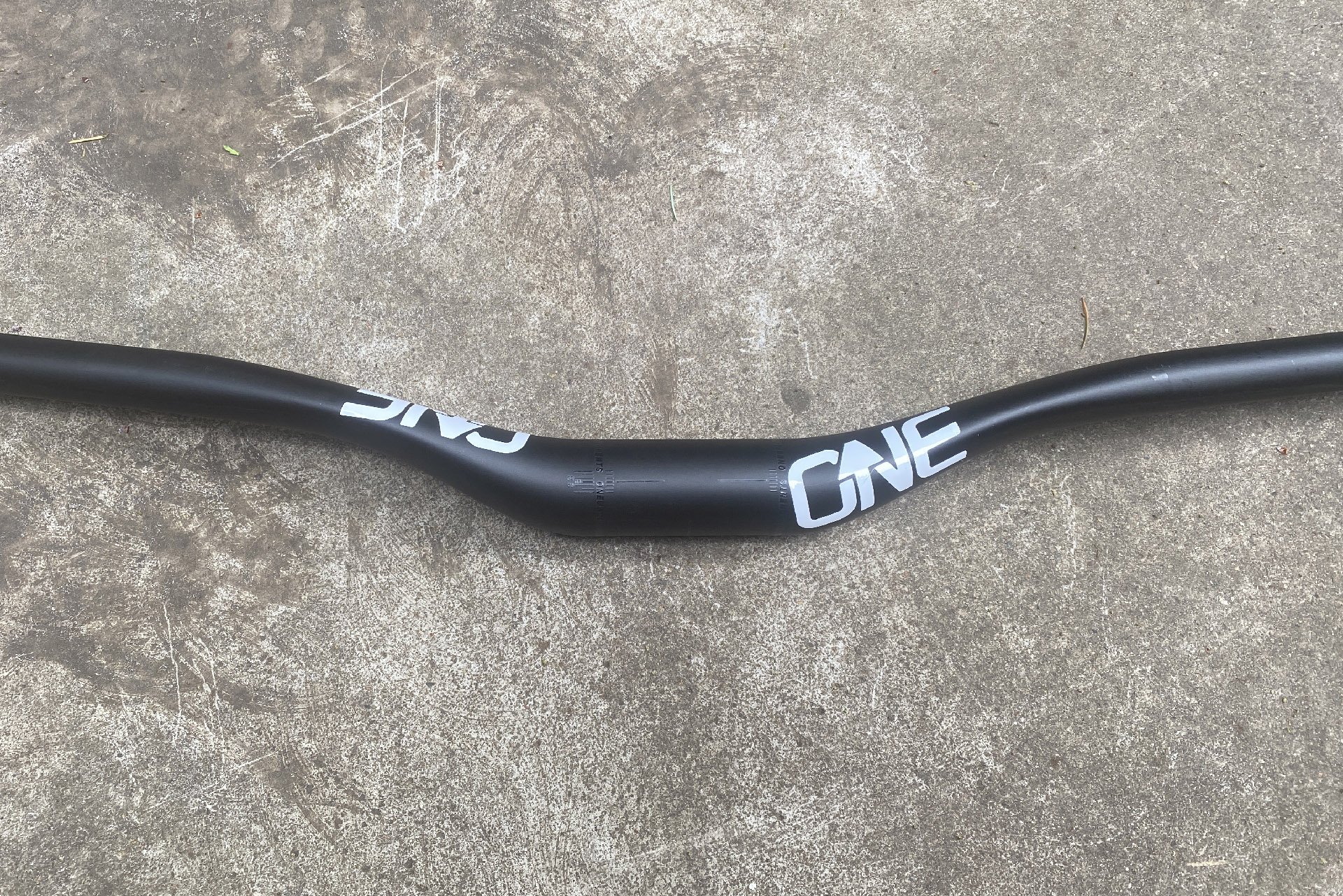
The vertical thickness measurement of the OneUp Carbon E-Bar is only 20 mm at its thinnest point, even thinner than the 22.2 mm grip area. The rise and sweep of the bars felt great to me.
The wires on most Shimano Steps-equipped bikes travel through the frame from the motor at the bottom bracket and then emerge at the headtube. From there they span a short distance to the handlebar-mounted display. A separate wire emerges from the display and travels to the controller, which allows you to adjust the boost level with your thumb, that is generally mounted next to the non-drive side grip. This wire can be supported with zip ties, tape, or clips but it remains vulnerable. Unlike hiding cables or brake lines, tucking away wires is more than an aesthetic consideration. If you crash and damage the wire to your controller, you may be stuck a long way from home on a heavy bike that's not enthusiastic about being pedalled without assistance. OneUp's bar is designed to cleverly route the controller wire up through the bottom of the middle of the bar, out to the grip internally, where it emerges in a channel under your grip before doubling back to meet the switch. It was the first internal routing adventure I was looking forward to tackling.
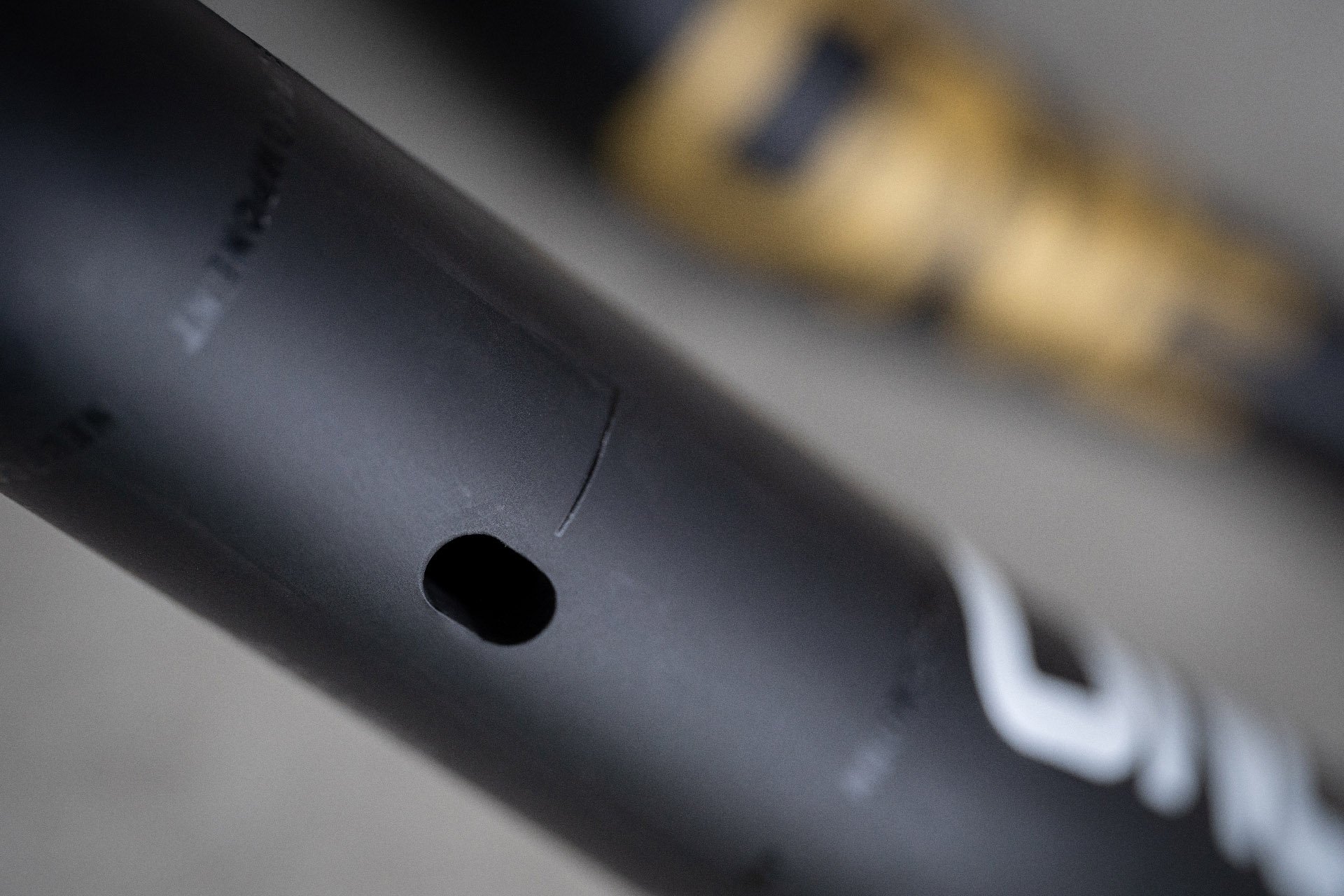
This opening, in the bottom of the middle of the bar, is to allow the controller wire to route through the middle of the bar. Photo - OneUp
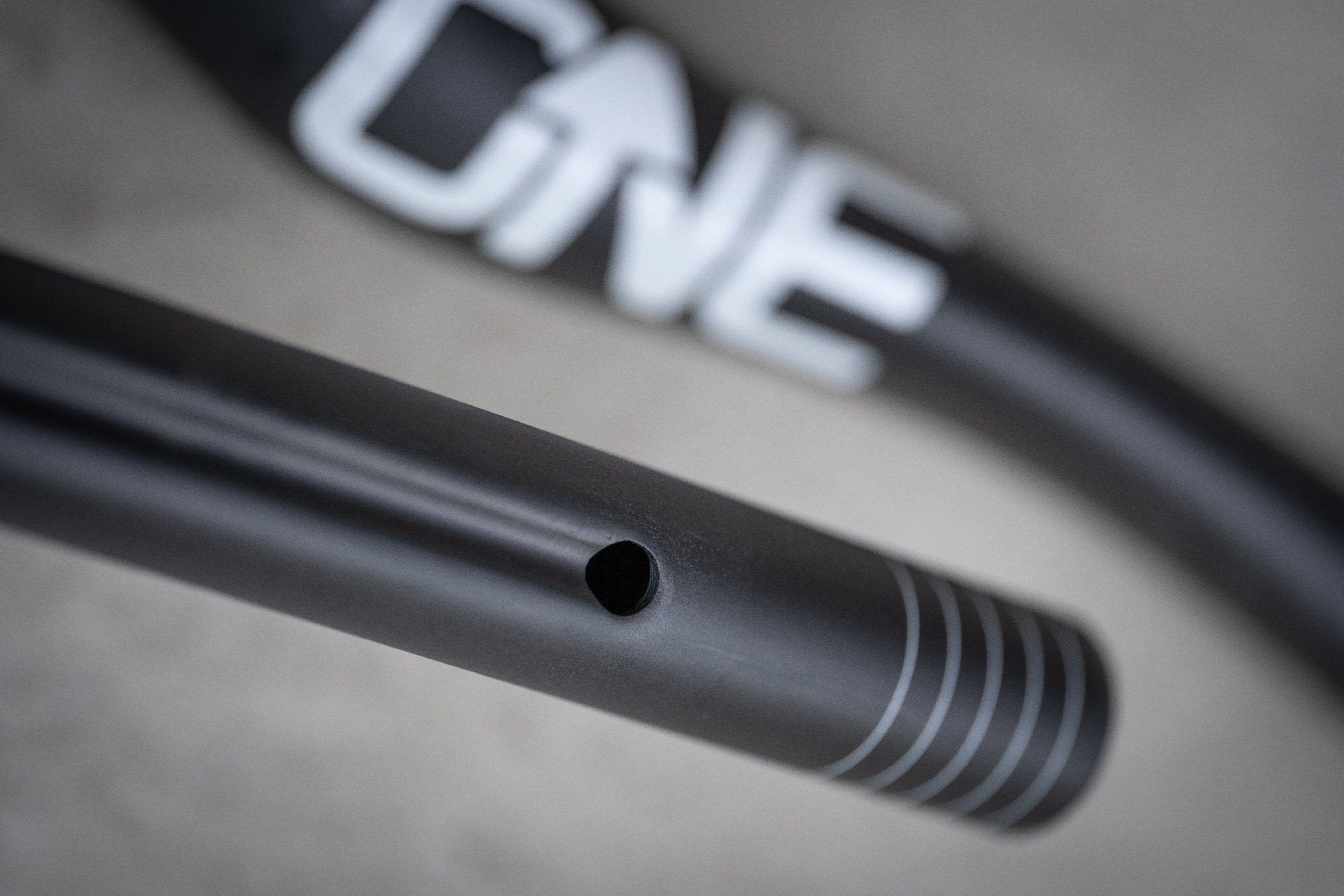
OneUp came up with an ingenious way to provide a tidy exit for the wire that works regardless of bar length. The channel allows the wire to emerge beneath the grip and travel back and plug into the controller. Photo - OneUp
Drilling holes in an aluminum bar would be insanity because the integrity of the structure depends on the continuity of the tube. A hole would inevitably cause the bar to fail under load. With carbon fibre, the lay up can be designed to compensate for holes so strength isn't compromised. In fact, the bar "passes the stringent Zedler E-MTB Advanced Plus standard and the international DH standard (ASTM Cat. 5 Downhill)."
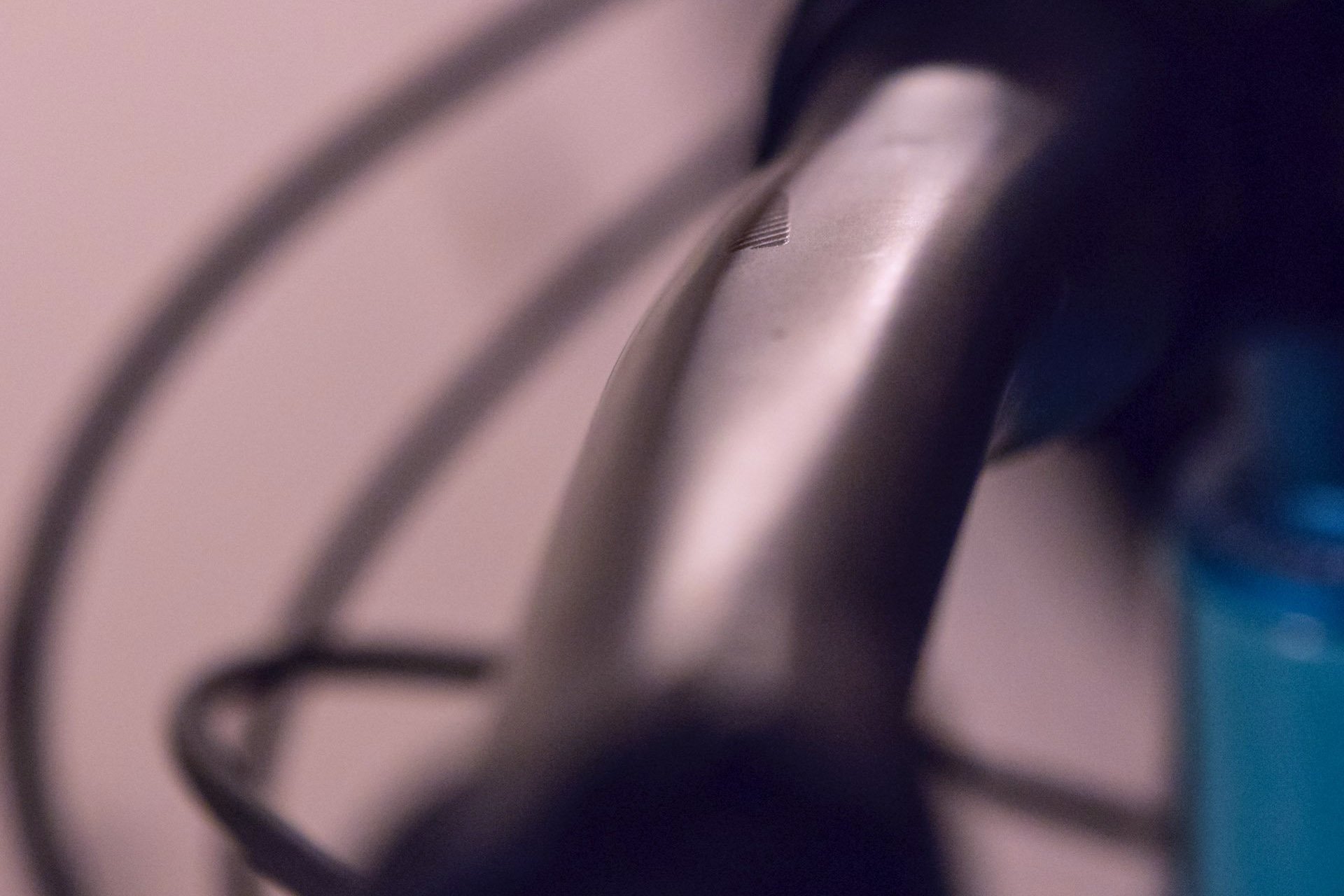
The shape of the original OneUp carbon bar, which is also laid up with a focus on compliance, had a less organic shape and appears less out of round when compared to the Carbon E-bar.
Anyone who has spent a lot of time riding a heavy, full-power eMTB on challenging technical terrain will attest that it can be punishing to your upper body, wrists, hands and forearms. I have a friend who sold his eMTB because it was too hard on this shoulder. When I began testing the Norco Sight VLT, this effect was more pronounced than usual. It didn't take me long to realize that the culprit was the Deity Skywire 35mm carbon bar. I swapped it out for an old favourite 750 mm (uncut) aluminum Bontrager bar from the days when bars didn't all come 800 mm long stock. If a bar hits the sweet spot in terms of strength and stiffness for a 220-pound rider at 800 mm it's often too stiff for a smaller rider once it's cut to 750 mm (for example), decreasing the leverage that can be applied by the rider. Everything felt significantly better once I swapped in the Bontrager bar and my enjoyment of the bike began in earnest.
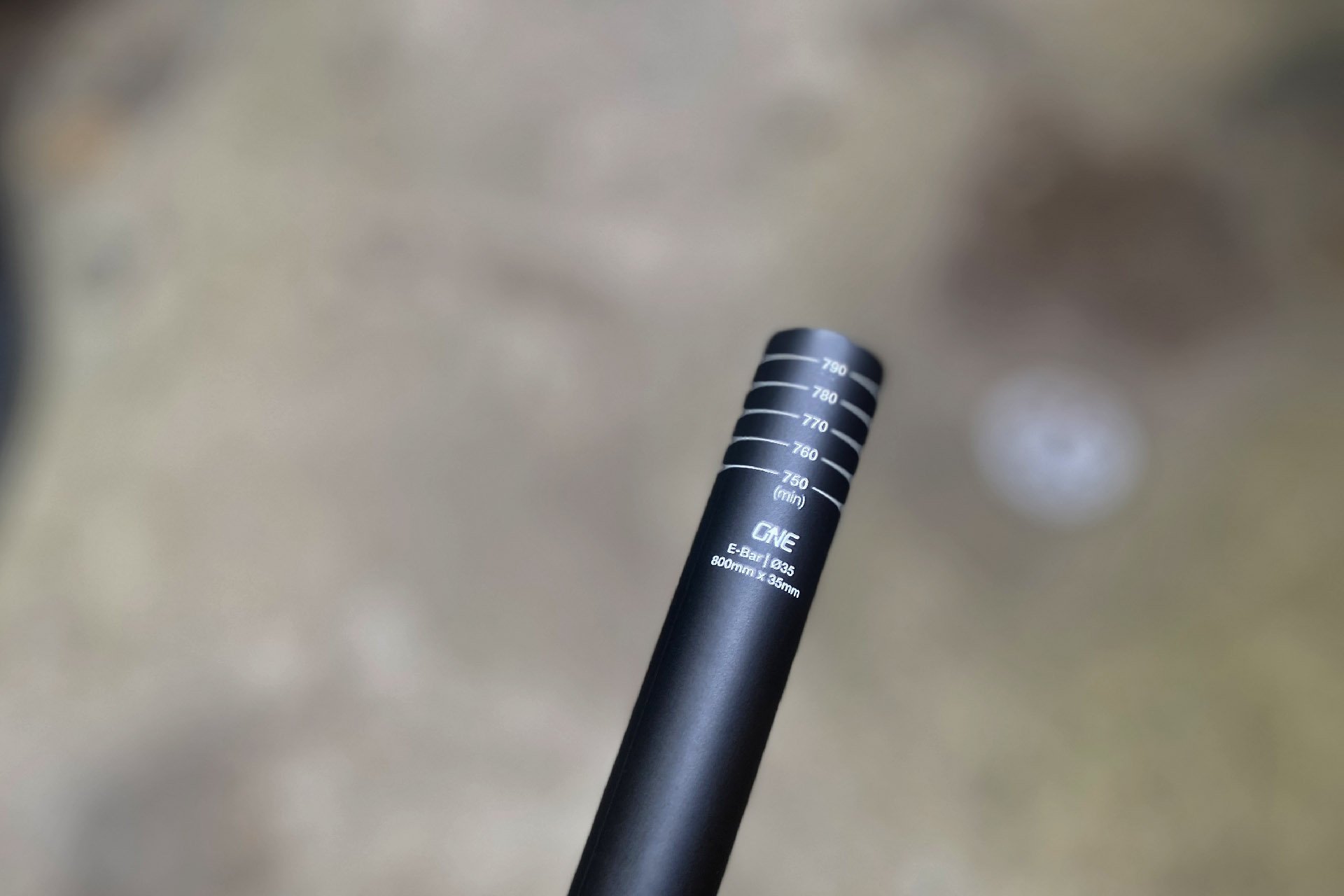
Everything is very well marked, including guides for cutting to length.
Install
Before I installed the OneUp Carbon E-Bar I ran into a snag. The internal routing depends on a stem that allows the bottom of the centre of the bar to be exposed, as the OneUp stem does. OneUp didn't provide a stem to go along with testing the bar but I could have removed one from another bike. That became a moot point when I checked the length of the wire and discovered it was far too short. I had been hoping to use my magnetic routing tool to pull the wire through the bar but that's going to have to wait until I can track down a replacement wire that is at least 650 mm long, 150 mm or so longer than the stock wire. And that's assuming your controller has a removable wire. If not you'll have to purchase a new controller and a new wire.
After that it was a conventional install but since the bar's compliance depends upon aligning the flattened section to the angle of the forces coming through the front wheel, it should be rotated based on the bike's head angle. OneUp's mounting guide has indicators so you can easily choose the right position based on your bike's geometry.
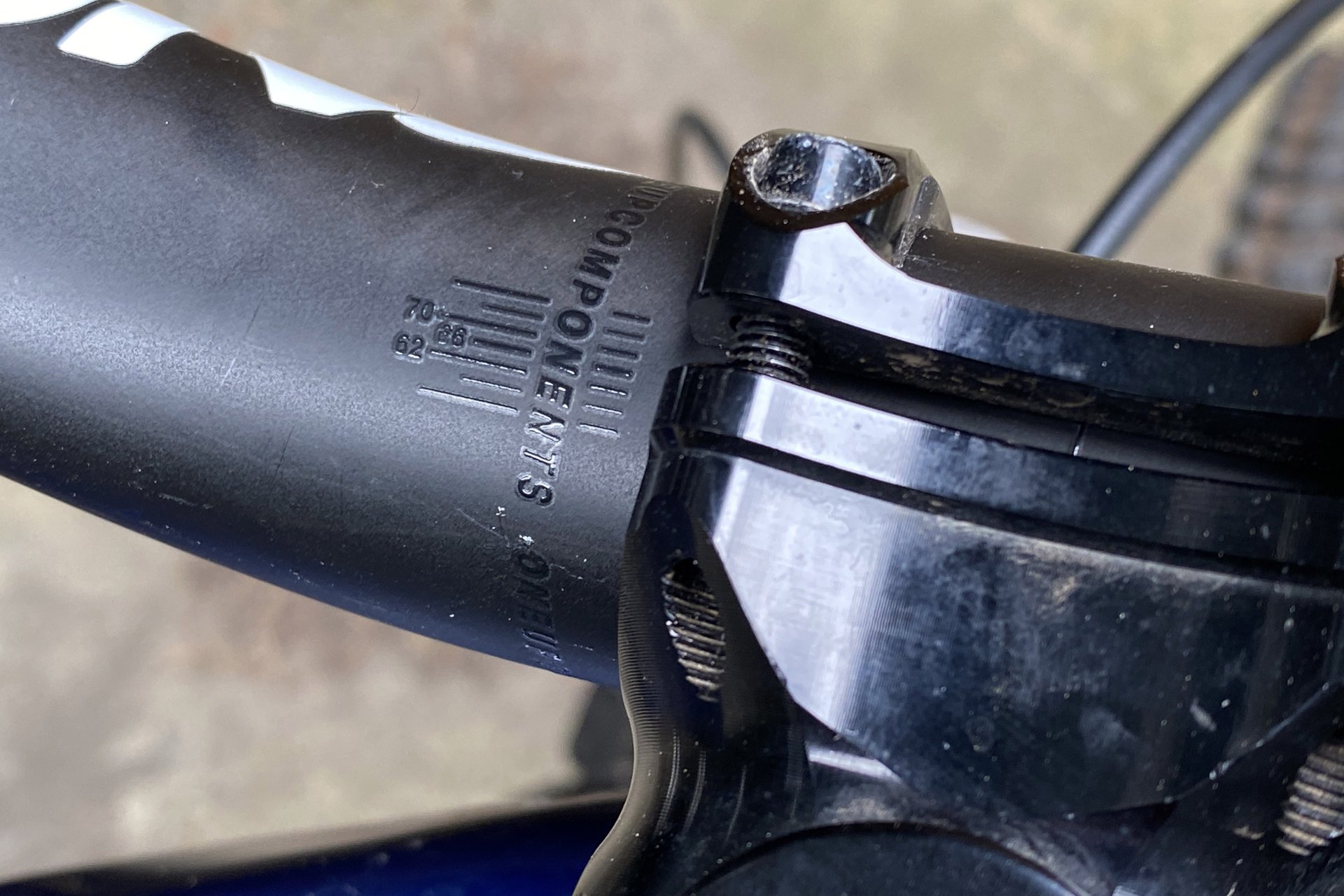
When used with a OneUp stem, this guide easily allows you to rotate the bar to the appropriate position based on your bike's head angle. Fortunately it's easy to decipher without a OneUp stem as long as you can determine the top of vertical axis of the bar.
OneUp Carbon E-Bar Specs
- 800mm Wide / 35mm Diameter / 8° Backsweep / 5° Upsweep
- Stealth Routing: Wire ports & grooves for remote
- Colour: Black. Decal Kits: Red, Green, Blue, Orange, Gold, Matte Bronze, Black, Purple, Oil Slick and White
- Strength: Zedler E-MTB Advanced Plus and ASTM Cat. 5 Downhill
- Minimum Trim width: 740mm
- Weight: 238g
- Price: 189 CAD / 149 USD with free shipping worldwide
Does it Comply?
I have ridden OneUp's first carbon handlebar, which was designed for un-assisted bikes, but I wasn't impressed initially. As it turned out, I hadn't read the effing manual and used OneUp's indicator to rotate the bar to the correct point. Like the Carbon E-Bar, the layup was designed to be compliant along the plane where forces are transferred from the ground to your hands (roughly vertical) but to resist torsional forces. I placed the bar at the wrong angle and as a result I found the bar to actually be a little too stiff. Once I got the rotation right I noticed the added compliance immediately.
OneUp declares, without providing evidence to my knowledge, that their bar is the most compliant eMTB-rated handlebar there is. In fact they declare it's 20% more forgiving than the competition. This bar had a tougher act to follow however, considering it was replacing my goldilocks aluminum Bontrager. I'd say Goldilocks has been replaced however because OneUp's feel is brilliant. I went for a big challenging ride in slippery conditions for its debut and it exceeded my expectations and felt both a little more compliant and more precise than the Bonty bar. Without considering the impact of the bar at the time, I found myself easily choosing lines that required a lot of accuracy with a high success rate. I can't say this was entirely due to the bar but I'd guess it was at least a contributing factor.
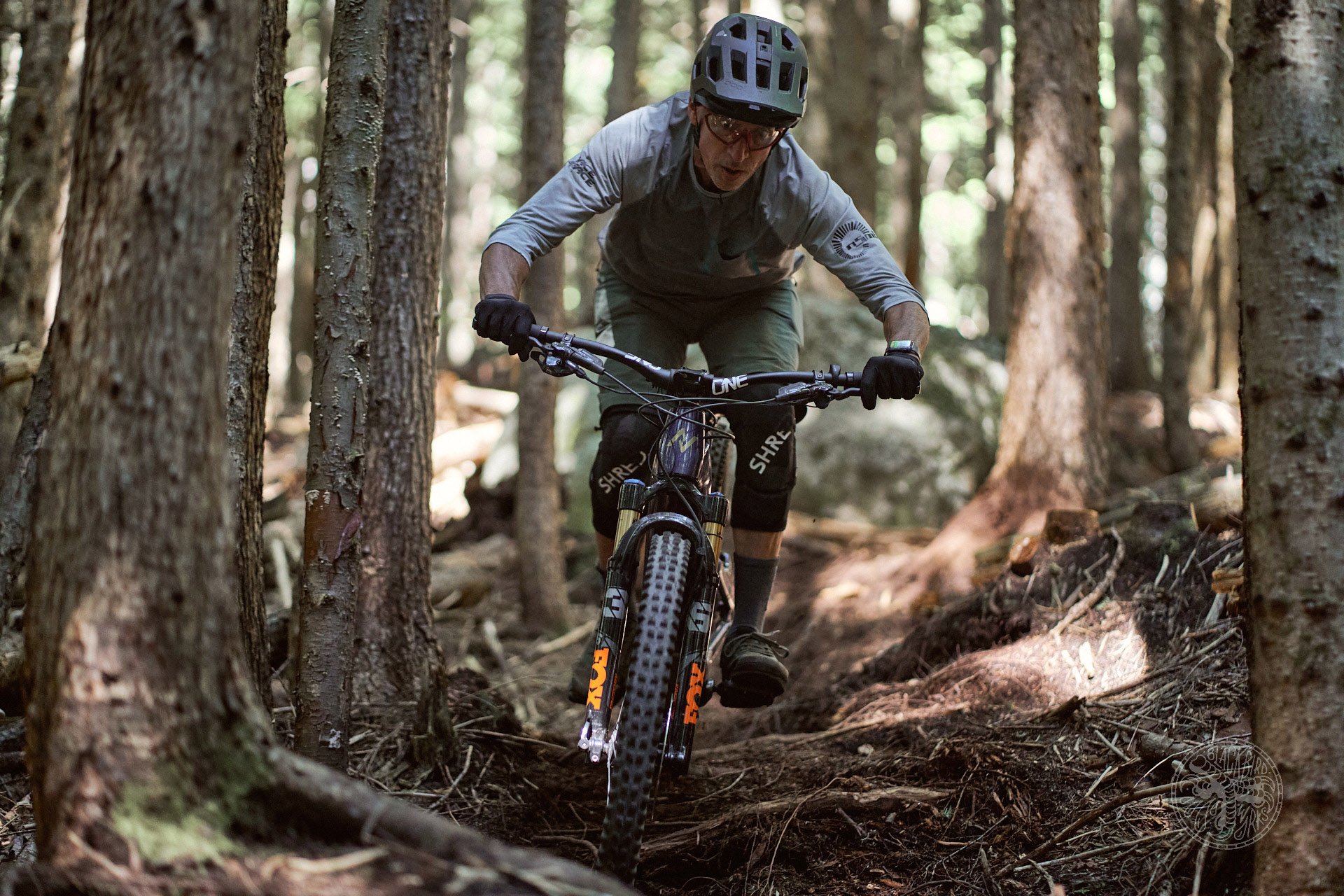
This was a day to try a couple of new products. I also installed Loam Labs' Counterpunch and grips which may be my favourite product of the year. After just one ride I felt certain I want a set on every bike I ride. They are going to make me ride differently and deliberately lean on or scuff trees on occasion. Once this becomes second nature, it will be hard to disengage these habits when riding a bike without Counterpunch. Photo - Deniz Merdano
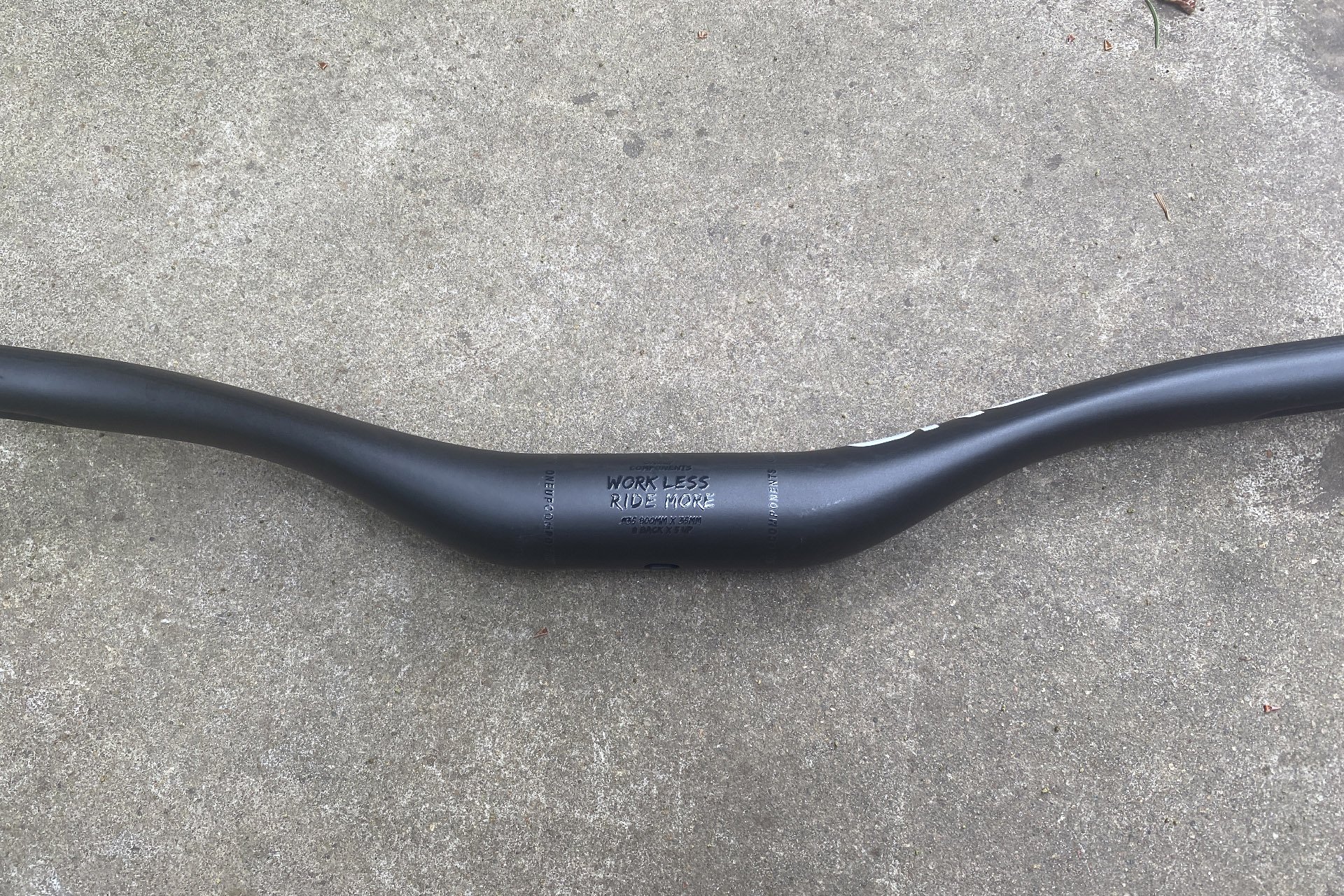
It even looks compliant.
Provisos
Having to find a new and longer controller wire during the never-ending supply chain gong show isn't ideal, but thus far the feel of the bar has almost made me forget about concealing the wire. You'll also likely have to add the price of a OneUp stem to your purchase ( 110 CAD/90 USD) but other stems with two piece faceplates should work as well.
The final consideration is that this is not a one-size-fits-all eMTB solution in terms of concealing and protecting your controller wire. It won't work with the Bosch Purion, Rocky Mountain, or Specialized remotes but there are more compatibility notes which you should take note of as well.
Verdict
My takeaway is that the OneUp Carbon E-Bar is a very comfortable but robust feeling solution for holding onto your eMTB that enhances my ride experience.
The OneUp Carbon E-Bar will lighten your wallet by 190 CAD / 150 USD.
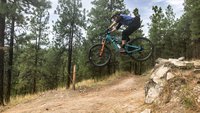
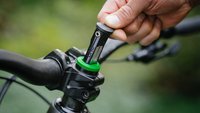
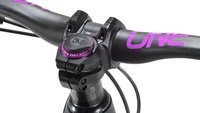
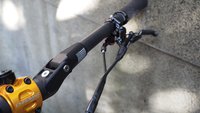


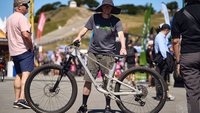
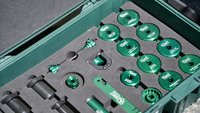
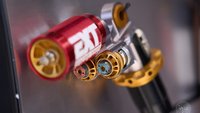


Comments
Ryan Walters
1 year, 8 months ago
The regular OneUp bar (and I assume the e-bar) has 2 sets of angle indicators - one to line up with the gap between the stem face plate, and another set that lines up with angle indicators on the front of your stem face plate (more accurate). Most stems (not all) will play well with the indicators. I run a Race Face Atlas stem, and the face plate has a 0 degree bar rotation mark that you simply line up with the head angle measurement of your bike, which is indicated on the bar itself. In my case, I line up the 0 degree mark on the stem with the 64 degree mark on the bar. Done.
Reply
4Runner1
1 year, 8 months ago
I run the same setup. Works like a charm.
Reply
Chris
1 year, 8 months ago
Rotating the bar for best compliance vs preferred backsweep/upsweep orientation seems counterproductive. Isn't this the very reason those silly one piece bar/stem combos are generally dismissed?
Reply
Ryan Walters
1 year, 8 months ago
Yup, this is a potential issue with the OneUp bar. If you tend to roll your bars wildly from the "normal" orientation, you might not get along with them. I guess I'm lucky in that the optimal OneUp orientation is basically how I would run my bars anyway.
Reply
Agleck7
1 year, 8 months ago
I don’t have a oneup stem and find it really tricky to get the roll correct. Is the HA marker supposed to be roughly in line with the angle the fork is contacting the ground or perpendicular to the actual ground? When I tried to approximate the latter it seems like the bar is rolled way too far forward.
Reply
Ryan Walters
1 year, 8 months ago
This pic shows the angle graduations on the stem - not all stems have them, but they come in handy, especially with the OneUp bar.
Reply
Agleck7
1 year, 8 months ago
Thanks! Unfortunately the Anvl stem only has the markings on the rear (not faceplate) which is the one place the One Up bar doesn’t have the angle markings. But I didn’t notice the ones on the front and between the two think I’m in the ballpark
Reply
handsomedan
1 year, 8 months ago
More backsweep please!
Reply
Cr4w
1 year, 8 months ago
No. We are all the same. Everyone gets the same backsweep and upsweep. No exceptions.
Reply
Andeh
1 year, 8 months ago
Just a heads up, my buddy put this bar on his Turbo Levo. The groove for the controller is too shallow for the fat wire housing on the Specialized bikes. Even with greasing the wire housing, you still have a good chance of tearing the housing with the inner lockring of a grip.
Reply
Suns_PSD
1 year, 8 months ago
The markings on my 2 sets of OneUp bars are so faded from new that it's not possible to make out what the angles even are.
Reply
Please log in to leave a comment.